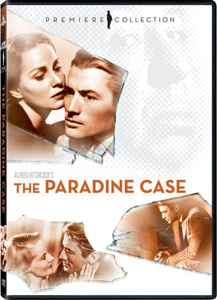Alfred Hitchcock’s “The Paradine Case” (1947) is so nice looking and features such great performances that it almost overshadows the thin story by uber-producer David O. Selznick, in one of his rare writing credits, adapting Robert Hichens’ novel.
Is the solution black and white?
Interestingly, in this final black-and-white film before Hitchcock’s first color effort, the next year’s “Rope,” two distinct “looks” can be found uploaded on YouTube. (No legit versions are streaming at the time of this writing.) In the one I watched, I’m tempted to credit cinematographer Lee Garmes with a brilliant choice to darken the blacks and enhance the shadows.
This version thematically emphasizes the idea of black and white in the “evil and good” murder story. Notably, when lawyer Anthony Keane (Gregory Peck) and we are introduced to Andre Latour (Louis Jourdan), the butler of the murdered man, Latour’s face remains hidden in shadow.

“The Paradine Case” (1947)
Director: Alfred Hitchcock
Writers: David O. Selznick (screenplay), Alma Reville (adaptation), Robert Hichens (novel)
Stars: Gregory Peck, Alida Valli, Ann Todd
This is also the case in the more traditionally lit version, featuring the crisper grays of something like “Alfred Hitchcock Presents,” so I’m confident that it’s fair to credit Garmes with executing a vision. Combined with the uber-femme fatale performance by Alida Valli as Mrs. Paradine, whom Keane is defending in the murder trial, I think it’s safe to say Hitchcock was going for a film noir vibe. And he achieves it.
But it’s intriguingly mixed with an Old Hollywood sensibility, as would later be seen when Peck even more famously plays a lawyer in “To Kill a Mockingbird” (1962). He has a deep voice that suggests we can trust Keane’s core morality. While a lot of the film is indoors, that classic cinema feel intervenes when Keane rides in a horse-drawn coach to the Paradines’ country estate.
Justice may not be blind, but it can be dark
The murder victim is blind, perhaps partly explaining the choice to make his mansion dark and shadowy. The courtroom is also that way (“Justice is blind”), and although the set designers are of course copying the way British courtrooms really look, I’m struck by the claustrophobia.
American courtrooms have space for the lawyers to pace around, but British courtrooms are jam-packed with officials and observers. Even if someone is guilty, the cruelty of the whole system is striking, with touches such as the judge being called “Lord” and the defendant being called “the prisoner” and being displayed in the dock, rather than joining her lawyer at a table.
I suspect the script was among the least concerns of Selznick when making “The Paradine Case,” as the promotional materials emphasize the all-star cast. We’re supposed to have a love triangle between Keane, his wife Gay (Ann Todd) and Mrs. Paradine. Although I can’t quibble with the performances, I don’t really believe Keane is in love with his client to the point of endangering his marriage.

Mrs. Paradine has a dark sexiness in that noir style, but Gay is beautiful and loyal. Granted, the dialog does explore this, as Selznick – working from Alma Reville’s adaptation of the novel – delivers a solid scene wherein Gay outlines to a friend her philosophy of sticking with her husband.
She is hurt, but she can see he is not proud of falling for Mrs. Paradine, and he’s doing everything he can to stay with Gay. This is another of “The Paradine Case’s” interplays: an old-school strong marriage versus the less definable appeal of a femme fatale who might be a cold-blooded poisoner.
A letdown as a mystery (Spoilers)
That brings me to another aspect of the film that’s interesting to discuss but not executed with verve. (SPOILERS FOLLOW.) While “The Paradine Case” is in part a murder mystery, the story is not filled with clues. It’s more about the melodrama of Keane grilling his client in their private discussions and grilling Latour in the witness box.
Nor is it filled with suspects. Mr. Paradine could’ve poisoned himself without any assistance, but it seems unlikely, not only logistically but also because he’s an object in the narrative more so than a character. No actor is cast in the role; we only see a painting of him. That leaves only Mrs. Paradine and Latour as suspects.
Selznick could’ve done a variation on the trope wherein they both have to be found not guilty because there’s a chance the other one could’ve done it. But because of the emotional connection between the two suspects, and their senses of loyalty and decency that bely the dirty deed one of them committed, they aren’t actually scheming together. “The Paradine Case” turns out to be a character piece all along.
As such, even though this is a rare Hitchcock film where the wrongfully accused person actually committed the crime, there’s no dramatic surprise, like there is in “The Witness for the Prosecution” (like this film, featuring Charles Laughton) 10 years later. So I don’t get to do an inverse of the “Naked Gun” line and say “By god, she is guilty!”
(END OF SPOILERS.)
Certain choices by Selznick and Hitchcock make “The Paradine Case” flatter than it could’ve been as a character drama. But it looks so good, and the performances are compelling enough that it’s not guilty of being boring.
RFMC’s Alfred Hitchcock series reviews works by the Master of Suspense, plus remakes and source material. Click here to visit our Hitchcock Zone.

